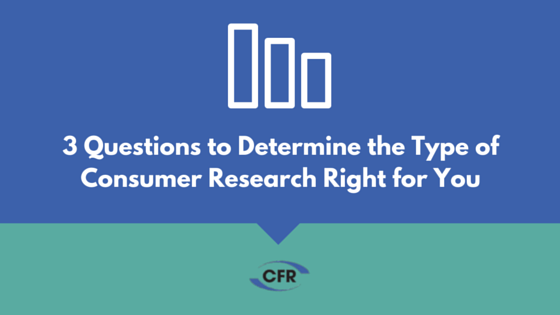
3 Questions to Determine the Type of Consumer Research Right for You
Conducting consumer research can be one of the smartest choices a business could make because of its ability to yield significant return on investment.
However, these businesses will want to ensure that the methodology, instruments and design type of their consumer research study fits their needs—otherwise, the benefits will be far more marginal.
To help organizations of all sizes determine what the optimal types of consumer research might be, they can answer the following 3 questions:
Do I Want to Know Their Opinion of Us/Our Products Specifically, Or Do I Want to Know About Their Purchasing Decisions in General?
A large percentage of research projects aim to know how people react in general when faced with certain purchase decisions. Going deeper, these research teams are trying to discover opinions, habits, conditional factors and other relevant circumstances that guide a consumer’s purchase decision towards one product or the other. With this information in hand, an organization can craft new products specified to the needs of their target market.
Answering research questions needed to make forward-thinking product decisions most often necessitates an opinion and demographic market research survey or a qualitative voice of the customer study.
Brands that want to know more about how consumers feel about their products specifically may want to look beyond mere sales data. Unlike the aforementioned organization above, they are less concerned with general opinions and decision-making habits. Organizations like these may want to conduct focus groups, engage in social listening surveys or poll consumers on specific brand preferences.
Do I Want to Capture an Image of My Entire Market, Or Do I Want to Know About Specific Segments?
Segmenting as a marketing strategy allows brands to leverage individual demographic groups to lift sales rather than trying a broad approach as a whole. Learning about segmenting data can also allow for the crafting of products that meet a wide range of tastes and needs.
For brands that want to be able to target segments with specificity, quantitative studies with stratified, random sampling should be used.
Other brands may want to be able to describe their audience more generally, allowing any segmenting trends to emerge naturally rather than attempting to observe them as an outcome of the research study. For these brands, a quantitative study with pure random sampling should be used. However, theY should check the respondent diversity against known demographics to prevent skewing or bias towards one group, which can yield only a partial picture.
Am I Trying to Describe Known Trends with More Accuracy, or Am I Trying to Discover Entirely New Ones?
Quantitative research has many strengths, but the ability to discover ideas completely unconsidered is generally not one of them. Most possibilities in quantitative surveys or observational methodology limit themselves to a few options, whereas deep qualitative interviews or focus groups can yield unexpected ways to describe a trend. Such is the difference between asking people if they use a product for X reasons compared to discovering a completely unconsidered use for said project.
Which of the Types of Consumer Research Is Right for You?
If these questions only helped you get part of the way towards a concrete answer, simply tell us about your market research goals, and we can respond with advice on the best options you have for moving forward.


